[1]
ZHAI J M, LI X Y, WU M Y, ZHANG Y L, Corrosion behavior of 45# steel in hydrogen sulfide solutions[J]. CORROSION & PROTECTION, 2013, 34(11): 1013-1018.
Google Scholar
[2]
LI Y T, DU Z Y, SUN L F, TAO Y Y, Resistance to HIC of high grade pipeline steels[J]. Journal of Iron and Steel Research, 2008, 20(12): 50-54.
Google Scholar
[3]
CHENG SH SH, WANG J G, WANG ZH G, Hydrogen sulfide corrosion of metal equipment in oil and gas field[J]. PETROLEUM DRILLING TECHNIQUES, 2011, 39(1): 32-35.
Google Scholar
[4]
YANG X Y, Hydrogen sulfide corrosion and protection for piping in oil refining plant[J]. CHEMICAL ENGINEERING DESIGN, 2013, 23(4): 37-40, 46.
Google Scholar
[5]
HAO W K, LIU ZH Y, ZHANG X, DU C W, LI X G, LIU X, Effect of H2S concentration on stress corrosion cracking behavior of 35CrMo steel in an artificial solution simulated drilling well waters at oil field[J]. Journal of Chinese Society for Corrosion and Protection, 2013, 33(5): 357-362.
Google Scholar
[6]
WANG J, BI Z Y, ZHANG J N, WANG Y, LI CH, BAI H, HE SH L, WANG T, Current status of casing/tubing corrosion and protection technology[J]. Welded Pipe and Tube, 2013, 36(7): 57-62.
Google Scholar
[7]
NACE International. NACE Standard MR0103 - 2010, Materials resistant to sulfide stress cracking in corrosive petroleum refining environments[S]. Houston, 2010: 2-3.
DOI: 10.3403/30261097u
Google Scholar
[8]
CHEN M, CUI Q, Current research status and progress of H2S corrosion mechanism and prevention[J]. Petroleum Engineering Construction, 2010, 36(5): 1-5.
Google Scholar
[9]
ZHANG Y L, XU J Q, WANG Y C, Stress corrosion and residual stress of H2S in petrochemical special equipment[J]. Engineering Sciences, 2009, 11(8): 38-43.
Google Scholar
[10]
LIU W, PU X L, BAI X D, ZHAO H W, Development of Hydrogen sulfide corrosion and prevention[J]. PETROLEUM DRILLING TECHNIQUES, 2008, 36(1): 83-86.
Google Scholar
[11]
ZHANG F CH, LI CH F, FU AI H, The theoretical research progress of sulfide stress corrosion cracking[J]. Materials Review, 2012, 26(20): 345-348.
Google Scholar
[12]
CHAO J R, HUAN J B, WANG W Z, Study on anti-SSCC performances of several steel[J]. Corrosion & Protection in Petrochemical Industry, 2012, 29(2): 16-18, 37.
Google Scholar
[13]
WANG P, CHEN F Q, SHI Y F, WU K G, HUANG ZH Y, Research on hydrogen induced crack of X80 pipeline steel[J]. Hot Working Technology, 2013, 42(16): 208-211.
Google Scholar
[14]
ZHANG W F, LIANG Y F, ZHU J H, The study on HIC of petroleum pipe steel[J]. Journal of Xi'an Highway University, 1998, 18(3): 91-93.
Google Scholar
[15]
REN X CH, CHU W Y, LI J X, SU Y J, QIAO L J, Influence of inclusions on initiation of hydrogen blister in iron[J]. ACTA METALLURGICA SINICA, 2007, 43(7): 673-677.
Google Scholar


